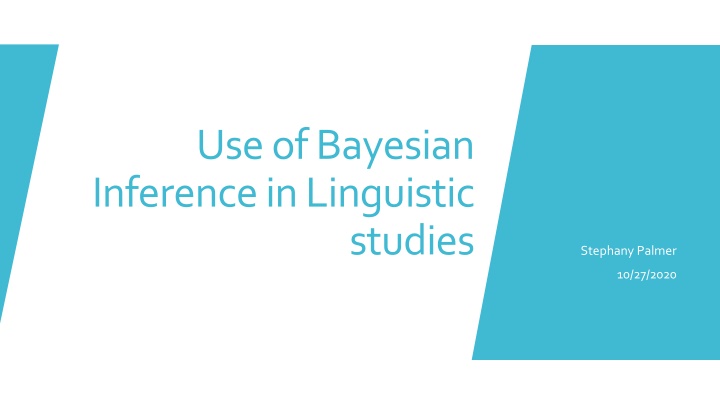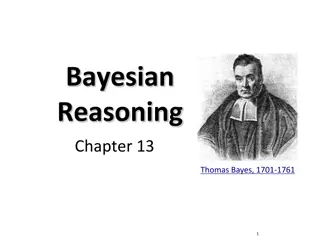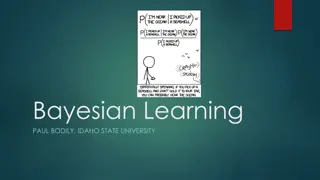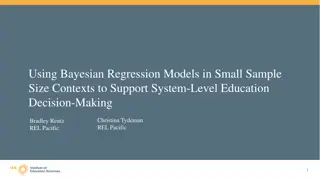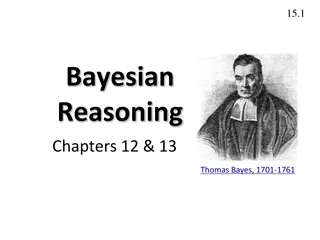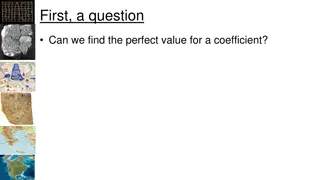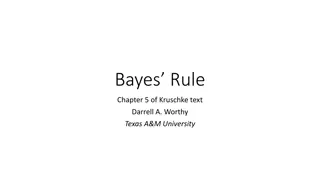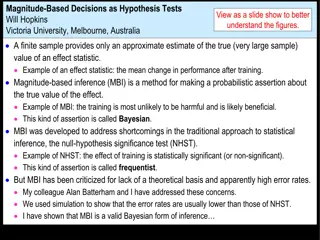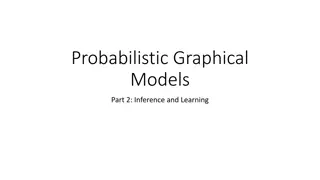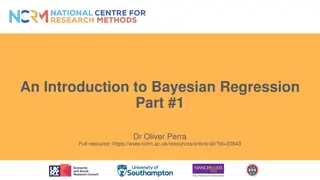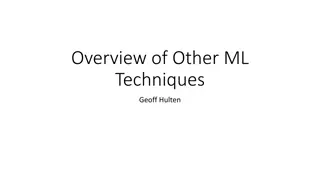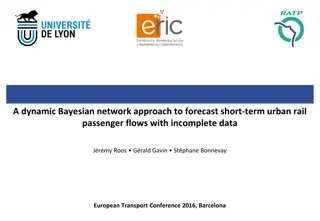Bayesian Inference in Linguistic Studies: Exploring Data Analysis Methods
Use of Bayesian inference in linguistic studies for analyzing data. Understand the differences between frequentist and Bayesian probabilities. Learn about Bayes' Theorem, Bayesian inference process, and the importance of choosing priors carefully.
Download Presentation

Please find below an Image/Link to download the presentation.
The content on the website is provided AS IS for your information and personal use only. It may not be sold, licensed, or shared on other websites without obtaining consent from the author.If you encounter any issues during the download, it is possible that the publisher has removed the file from their server.
You are allowed to download the files provided on this website for personal or commercial use, subject to the condition that they are used lawfully. All files are the property of their respective owners.
The content on the website is provided AS IS for your information and personal use only. It may not be sold, licensed, or shared on other websites without obtaining consent from the author.
E N D
Presentation Transcript
Use of Bayesian Inference in Linguistic studies Stephany Palmer 10/27/2020
You collect data, what can you do with it? Descriptive Statistics: summarize your sample Mean Variance Standard Deviation, etc. Data/ Information analysis Inferential Statistics: find out something about the population, not just your sample
Frequentist Probability Bayesian Probability Classical method Data is real, some results are more plausible than others Frequentist vs Bayesian Unknown can only be estimated Use of prior knowledge Can t say actual probability is equal to Can say there is a 95% probability
A frequentist is a person whose long-run ambition is to be wrong 5% of the time. A Bayesian is one who, vaguely expecting a horse, and catching a glimpse of a donkey, strongly believes he has seen a mule.
Frequentists vs Bayesians Karl Pearson Thomas Bayes Ronald Fisher Pierre-Simon Laplace Jerzy Neyman
An example ? = 55%, 95% ?????????? ???????? = [44.72%, 64.96%].
An example
Bayes Theorem ? ? =? ? ? ? ? ? ? ?
Bayesian Inference Prior x Likelihood Bayesian Result Probability of our data, P(B), is ignored.
? ? =? ? ? ? ? ? ? ? The prior summarizes our knowledge before collecting data. This probability distribution can be based on previous studies and should be justified. Can be either vague/uninformative or highly informative, depending on how much is known. Prior
Choice of Priors Choose carefully. 1) Obtain a set of priors with different levels of representativeness for past research findings 2) Obtain a Bayesian result using each prior 3) Compare their credible intervals If big differences, priors aren t robust/useful
? ? =? ? ? ? ? ? ? ? The foundation of most frequentist techniques. Given our prior, how likely is it that we got our data? If our prior and our data are very different, we will get a low likelihood. Low likelihood-> prior is informative. Less informative the better. Likelihood
? ? =? ? ? ? ? ? ? ? Given our data, how likely is it that our prior beliefs accurately represent the data? The posterior distribution contains the information needed for statistical inference and summarizes our knowledge of the parameters of interest based on: What we assumed at the beginning of the study, and What we have learned about our parameters after observing all the data. Posterior
The Bayesian equivalent of frequentist confidence intervals but can use stronger language in their interpretation due to the Bayesian definition of probabilities. 95% frequentist confidence interval for the difference in two group means might be ( 1.25, 0.55). The frequentist interpretation: confidence intervals constructed in this way can be expected to contain the true mean difference in 95% of studies. If we obtained the same values from a Bayesian credible interval, interpret them as: given the prior and model, we believe that the true mean difference lies between 1.25 and 0.55 with 95% probability. Credible Interval
Intuitive Advantages Easiertomodel now Don thavetoworry aboutthe populationparameters
Priors are subjective Disadvantages Computationally intensive Not as common-> used less in studies
Investigated the effect of the interaction mode (i.e., computermediated communication vs. face to face interaction) when they provided 24 intermediate level learners of Spanish with opportunities to modify their output during interactional feedback episodes with their teacher. Another Example After collecting their data, the authors conducted a paired samples t test to answer their research question, finding t(23) = 5.03, with descriptive results favoring the face to face environment.
Setup themodel the sameway. Set unknownparameters toprior. Can language proficiencybe predictedby language analytic ability. Bayesian Regression
Oleson, J. J., Brown, G. D., & McCreery, R. (2019). The evolution of statistical methods in speech, language, and hearing sciences. Journal of Speech, Language and Hearing Research (Online), 62(3), 498-506. doi:http://dx.doi.org.proxy.wm.edu/10.m44/2018 _JSLHR-H-ASTM-18-0378 References Hsu, Anne S., et al. The Probabilistic Analysis of Language Acquisition: Theoretical, Computational, and Experimental Analysis. Cognition, vol. 120, no. 3, 26 Mar. 2011, pp. 380 390. ScienceDirect, doi:https://doi.org/10.1016/j.cognition.2011.02.013. Norouzian, R., de Miranda, M. and Plonsky, L. (2018), The Bayesian Revolution in Second Language Research: An Applied Approach. Language Learning, 68: 1032-1075. doi:10.1111/lang.12310 Cthaeh, The, et al. Frequentist and Bayesian Approaches in Statistics. Probabilistic World, 19 Apr. 2020, www.probabilisticworld.com/frequentist-bayesian-approaches- inferential-statistics/.
